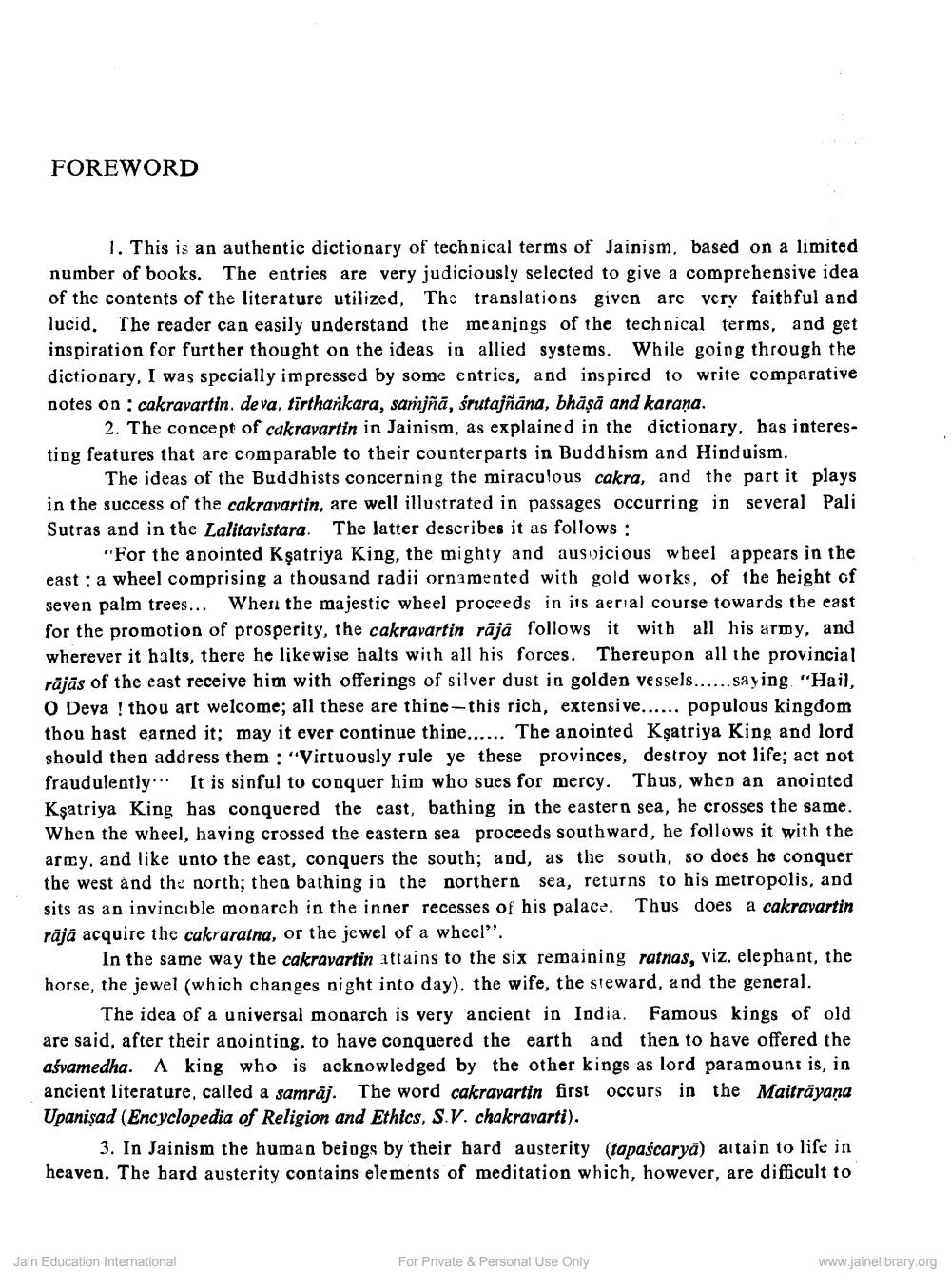________________
FOREWORD
1. This is an authentic dictionary of technical terms of Jainism, based on a limited number of books. The entries are very judiciously selected to give a comprehensive idea of the contents of the literature utilized, The translations given are very faithful and lucid. The reader can easily understand the meanings of the technical terms, and get inspiration for further thought on the ideas in allied systems. While going through the dictionary, I was specially impressed by some entries, and inspired to write comparative notes on cakravartin. deva, tirthankara, samjñā, śrutajñāna, bhāṣā and karana.
2. The concept of cakravartin in Jainism, as explained in the dictionary, has interesting features that are comparable to their counterparts in Buddhism and Hinduism.
The ideas of the Buddhists concerning the miraculous cakra, and the part it plays in the success of the cakravartin, are well illustrated in passages occurring in several Pali Sutras and in the Lalitavistara. The latter describes it as follows:
"For the anointed Ksatriya King, the mighty and auspicious wheel appears in the east: a wheel comprising a thousand radii ornamented with gold works, of the height of seven palm trees... When the majestic wheel proceeds in its aerial course towards the east for the promotion of prosperity, the cakravartin rajā follows it with all his army, and wherever it halts, there he likewise halts with all his forces. Thereupon all the provincial rājās of the east receive him with offerings of silver dust in golden vessels...... saying, "Hail, O Deva ! thou art welcome; all these are thine-this rich, extensive...... populous kingdom thou hast earned it; may it ever continue thine...... The anointed Ksatriya King and lord should then address them: "Virtuously rule ye these provinces, destroy not life; act not fraudulently." It is sinful to conquer him who sues for mercy. Thus, when an anointed Ksatriya King has conquered the east, bathing in the eastern sea, he crosses the same. When the wheel, having crossed the eastern sea proceeds southward, he follows it with the army, and like unto the east, conquers the south; and, as the south, so does he conquer the west and the north; then bathing in the northern sea, returns to his metropolis, and sits as an invincible monarch in the inner recesses of his palace. Thus does a cakravartin rājā acquire the cakraratna, or the jewel of a wheel”.
In the same way the cakravartin attains to the six remaining ratnas, viz. elephant, the horse, the jewel (which changes night into day). the wife, the steward, and the general.
The idea of a universal monarch is very ancient in India. Famous kings of old are said, after their anointing, to have conquered the earth and then to have offered the aśvamedha. A king who is acknowledged by the other kings as lord paramount is, in ancient literature, called a samrāj. The word cakravartin first occurs in the Maiträyana Upanișad (Encyclopedia of Religion and Ethics, S.V. chakravarti).
3. In Jainism the human beings by their hard austerity (tapascarya) aitain to life in heaven. The hard austerity contains elements of meditation which, however, are difficult to
Jain Education International
For Private & Personal Use Only
www.jainelibrary.org




